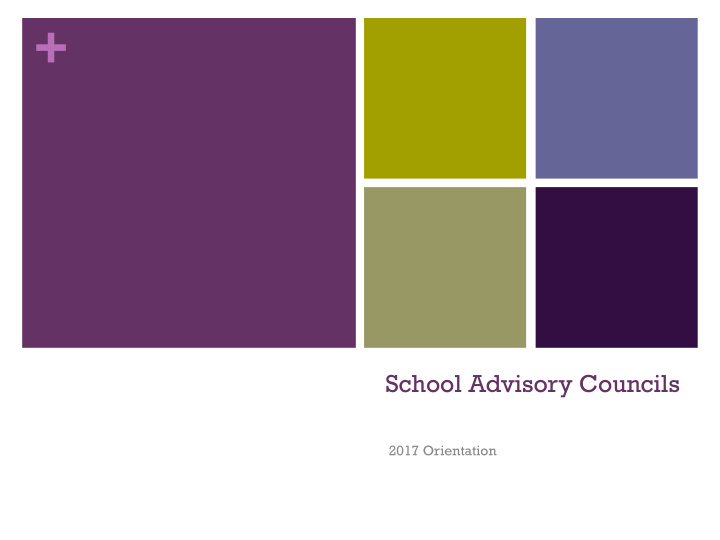



+ School Advisory Councils 2017 Orientation
+ Guiding Principles of SACs Education is a shared responsibility The best interests of students must be the first consideration for all decisions People at the local school level have important perspectives that should be considered in decision making School improvement leads to increased student achievement New policies should take into account the unique characteristics of each school community Partners need to use teamwork skills and strategies to manage change effectively Involving the school community in improving the school enhances learning for all students
+ SAC Membership No group can make up more than one third of the SAC unless the Letter of Agreement provides otherwise School Principal is nonvoting member, and an automatic one Members elected or appointed do not normally exceed three year terms Vary in size: minimum of 5 to maximum of 18 members Teachers elect teachers Support staff elect support staff Parents/guardians elect parent/guardians Students elect students Community members may be appointed or elected (specified in Letter of Agreement)
+ Expectations of SACs Participating in efforts to continuously improve student achievement and school performance, and recommending plan to school board/ contributing to annual report Advising school principal and staff on policies, curriculum and programs, school practices, student discipline, school communication, fundraising Reviewing cap sizes and rationale for exceeding guidelines Participation in selection of school principal Serving on various committees during reviews or replacements (School Options, Site Steering) Reviewing /Updating Letter of Agreement/By Laws Promoting Communication with school community partners
+ Items of Interest Chair represents SAC and collaborates with the principal in advisory role, establishes the agenda with the principal and ensures open lines of communication between SAC and school board, and the school community Create and amend Letter of Agreement ( document which sets out member composition and the responsibilities of the partners). Education Act provides the LoA may be amended and SAC may opt to review at each annual meeting Volunteer organizations that receive their authority from the Nova Scotia Education Act, established to provide parents/guardians, staff, community members and students with a voice to influence decisions that impact student learning SACs do not have a role in day to day operations of school, personnel matters or carrying out responsibilities of staff Time and date of all SAC meetings should be decided at first SAC meeting of the year Quorum: usually a simple majority of its members. Some SAC by-laws may require the presence of at least one representative of a certain group. Principal is not counted as a member when determining a quorum
+ Letter of Agreement Contains: Duration of the agreement ( ie: This agreement shall be reviewed annually by the SAC by June 30 of each year; any agreed upon revisions can be made at that time and submitted to SSRSB and DEECD for approval) Decision making structure (ie: All decisions will be made by consensus; in the event consensus cannot be reached, the decision will be delayed until the next meeting, and if a consensus cannot be reached, then a majority vote is required of the quorum) Structure of the SAC( ie: SAC shall include the following members …… . Names of members and their years of service can be detailed in an appendix to the by-laws) School Advisory Council’s commitments ( ie: Provide all SAC members with a voice in decision making; collaborate with all school staff to develop a school improvement plan … .) School Board’s commitments ( ie: Orientation and workshop sessions on special topics upon request; opportunities to give input on school board policies and procedures … ..) DEECD’s commitments ( ie: Developing educational materials to assist SACs in fulfilling their duties … ) Signatories to the agreement (ie: Principal, Chair, School Board Chair, DEECD)
+ Questions to Ponder: Question 1 What characteristics make for the most effective and influential SACs?
+ Question 2 How does an SAC membership support its school community of staff, parents/guardians and students and provide critical advice while still being able to navigate difficult decisions?
+ Question 3 What have been some of your SACs most rewarding accomplishments/chall enging decisions?
+ Question 4 How can we best showcase the work of our SACs within not only our own school community, but within our entire SSRSB system?
+ Question 5 Discuss strategies for how schools can generate more interest in SAC involvement and membership.
+ Thank You!
Recommend
More recommend